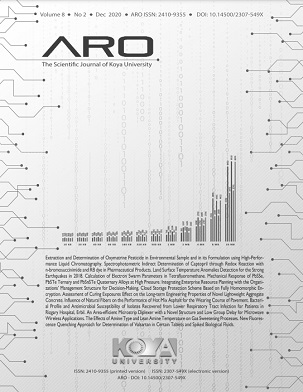Land Surface Temperature Anomalies Detection for the Strong Earthquakes in 2018
DOI:
https://doi.org/10.14500/aro.10591Keywords:
Anomaly detection, Earthquake, Land surface temperature, Remote sensingAbstract
Earthquake every year leads to human and material losses and unpredictability of it by now makes this natural disaster worsen. The objective of the current study was to determine the anomalies in land surface temperature (LST) in areas affected by earthquakes. In this research, three earthquakes (M >6) were studied. Moderate Resolution Imaging Spectroradiometer Aqua and Terra day and night LST data used from 2003 to 2018. The interquartile range (IQR) and mean ± 2σ methods utilized to select anomalies. As a result, based on the IQR method, no prior and after anomaly detected in selected cases and data. Based on mean ± 2σ, usually positive anomaly occurred during daytime. However, negative (or positive) anomaly occurred during the nighttime before the Mexico and Bolivia earthquakes. During 10 days after the earthquake, sometimes a negative anomaly detected.
Downloads
References
Allen, C.R., 1976. Responsibilities in earthquake prediction: To the seismological society of America, delivered in Edmonton, Alberta, May 12, 1976. Bulletin of the Seismological Society of America. 66(6), pp.2069-2074.
Anomaly.Io., 2015. Anomaly Detection with the Normal Distribution, Anomaly. Available from: https://www.anomaly.io/anomaly-detection-normal-distribution. [Last accessed on 2019 Jul 14].
Bhardwaj, A., Singh, S., Sam, L., Bhardwaj, A., Martín-Torres, F.A., Singh, A., and Kumar, R., 2017. MODIS-based estimates of strong snow surface temperature anomaly related to high altitude earthquakes of 2015. Remote Sensing of Environment, 188, pp.1-8.
Dancho, M., and Vaughan, D., 2018. Anomalize: Tidy Anomaly Detection. Available from: https://www.cran.r-project.org/package=anomalize. [Last accessed on 2019 Jan 03].
Dey, S., and Singh, R.P. 2003. Surface latent heat flux as an earthquake precursor. Natural Hazards and Earth System Science, 3(6), pp.749-755.
Geiß, C., and Taubenböck, H., 2013. Remote sensing contributing to assess earthquake risk: From a literature review towards a roadmap. Natural Hazards, 68(1), pp.7-48.
Geller, R.J., 1997. Earthquake prediction: A critical review. Geophysical Journal International, 131(3), pp.425-450.
Geller, R.J., 2011. Shake-up time for Japanese seismology. Nature, 472, pp.407-409.
Geller, R.J., Jackson, D.D., Kagan, Y.Y., and Mulargia, F., 1997. Earthquakes cannot be predicted. Science, 275(5306), pp.1616-1616.
Gorelick, N., Hancher, M., Dixon, M., Ilyushchenko, S., Thau, D., and Moore, R., 2017. Google earth engine: Planetary-scale geospatial analysis for everyone. Remote Sensing of Environment, 202, pp.18-27.
Jiao, Z.H., Zhao, J., and Shan, X., 2018. Pre-seismic anomalies from optical satellite observations: A review. Natural Hazards and Earth System Sciences, 18(4), pp.1013-1036.
Nezammahalleha, M.A., Noori, A.A., Afsharmanesh, H., Pourhosseini, Z., Rastegar, A., Rezai, H.S.S., and Alavipanah, S.K., 2013. Identification of active areas of earthquake by thermal remote sensing. International Archives of the Photogrammetry, Remote Sensing and Spatial Information Sciences, 1, pp.295-299.
Ouzounov, D., and Freund, F., 2004. Mid-infrared emission prior to strong earthquakes analyzed by remote sensing data. Advances in Space Research, 33(3), pp.268-273.
Ouzounov, D., Pulinets, S., Kafatos, M.C., and Taylor, P., 2018. Thermal radiation anomalies associated with major earthquakes. In: Pre-Earthquake Processes: A Multidisciplinary Approach to Earthquake Prediction Studies, Geophysical Monograph. Vol. 234. John Wiley, Hoboken, pp.259-274.
Rasul, A., Balzter, H., and Smith, C., 2016. Diurnal and seasonal variation of surface urban cool and heat Islands in the Semi-Arid City of Erbil, Iraq. Climate, 4(3), p.42.
Rawat, V., Saraf, A.K., Das, J., Sharma, K., and Shujat Y., 2011. Anomalous land surface temperature and outgoing long-wave radiation observations prior to earthquakes in India and Romania. Natural Hazards, 59(1), pp.33-46.
Saraf, A.K., Choudhury, S., Rawat, V., Banerjee, P., Dasgupta, P., and Das, J.D., 2008. Detecting earthquake precursor: A thermal remote sensing approach. In: Map India 2008-11th Annual International Conference and Exhibition on Geospatial Information, Technology and Application. pp.1-10.
Shen, H., Li, X., Zhang, L., Tao, D., and Zeng, C., 2013. Compressed sensing-based inpainting of aqua moderate resolution imaging spectroradiometer band 6 using adaptive spectrum-weighted sparse Bayesian dictionary learning. IEEE Transactions on Geoscience and Remote Sensing, 52(2), pp.894-906.
Streit, M., and Gehlenborg, N., 2014. Bar charts and box plots. Nature Methods, 11(2), p.117.
Tramutoli, V., Bello, G.D., Pergola, N., and Piscitelli, S. 2001. Robust satellite techniques for remote sensing of seismically active areas. Annals of Geophysics, 44, pp.295-312.
Tronin, A., 2009. Satellite remote sensing in seismology. A review. Remote Sensing, 2(1), pp.124-150.
Tronin, A.A., Hayakawa, M., and Molchanov, O.A., 2002. Thermal IR satellite data application for earthquake research in Japan and China. Journal of Geodynamics, 33(4-5), pp.519-534.
USGS.Gov., 2019. USGS Earthquake Hazards Program. Available from: https:// www.earthquake.usgs.gov. [Last accessed on 2019 Jul 14].
Wu, L., and Liu, S., 2009. Remote sensing rock mechanics and earthquake thermal infrared anomalies. In: Advances in Geoscience and Remote Sensing. Intech Open, London.
Wu, L., Zheng, S., Santis, A.D., Qin, K., Mauro, R.D., Liu, S., and Rainone, M.L., 2016. Geosphere coupling and hydrothermal anomalies before the 2009 Mw 6.3 L’Aquila earthquake in Italy. Natural Hazards and Earth System Sciences, 16, pp.1859-1880.
Zoran, M.A., Savastru, R.S., and Savastru, D.M., 2015. Satellite thermal infrared anomalies associated with strong earthquakes in the Vrancea area of Romania. Open Geosciences, 7(1), pp.606-617.
Downloads
Published
How to Cite
Issue
Section
License
Authors who choose to publish their work with Aro agree to the following terms:
-
Authors retain the copyright to their work and grant the journal the right of first publication. The work is simultaneously licensed under a Creative Commons Attribution License [CC BY-NC-SA 4.0]. This license allows others to share the work with an acknowledgement of the work's authorship and initial publication in this journal.
-
Authors have the freedom to enter into separate agreements for the non-exclusive distribution of the journal's published version of the work. This includes options such as posting it to an institutional repository or publishing it in a book, as long as proper acknowledgement is given to its initial publication in this journal.
-
Authors are encouraged to share and post their work online, including in institutional repositories or on their personal websites, both prior to and during the submission process. This practice can lead to productive exchanges and increase the visibility and citation of the published work.
By agreeing to these terms, authors acknowledge the importance of open access and the benefits it brings to the scholarly community.
Accepted 2020-08-07
Published 2020-09-01
















 ARO Journal is a scientific, peer-reviewed, periodical, and diamond OAJ that has no APC or ASC.
ARO Journal is a scientific, peer-reviewed, periodical, and diamond OAJ that has no APC or ASC.